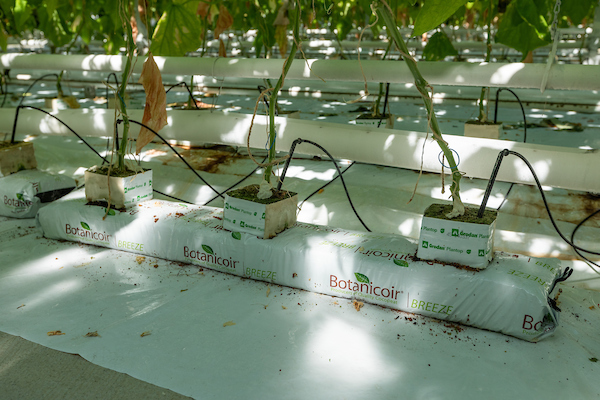Please click here to access the main AHDB website and other sectors.
- Home
- Knowledge library
- Using irrigation, pruning and harvesting to manage Mycosphaerella in cucumber
Using irrigation, pruning and harvesting to manage Mycosphaerella in cucumber
This information was last updated in 2015.
The targeted use of water and the removal of flowers and leaves can all help reduce the prevalence of this disease.
Irrigation
The timing, amount and composition of irrigation can influence Mycosphaerella infection.
High mineral nutrient levels and ECs in general lead to higher dry matter concentrations and lower Mycosphaerella risk.
Higher EC also reduces root pressure. High EC (>3.5) inhibits internal fruit rot, but the effect is cultivar-dependent.

Drip irrigation in a glasshouse cucumber crop
Stronger
In case of low EC (2.5), it is possible to compensate by increasing the calcium level to 180-200 ppm (4.5-5.0 mmol/l).
Calcium and potassium silicate decrease stem infection because they make the cell walls stronger.
Increasing the rates is also effective in reducing powdery mildew, but fruits become dull at high silicon dosages.
Limits of research
Research has not yet established differences in Mycosphaerella if irrigation was limited to shorter periods during the day. For example, from two hours after sunrise until two hours before sunset, compared to starting at sunrise and stopping at sunset (when the total water dose was the same).
Extremes such as severe water stress and water soaking both increase Mycosphaerella problems and may increase Pythium.
Dew formation
Cold irrigation water and low slab temperatures lead to dew formation at the stem base.
Heating the irrigation water (initially to 22 ̊C , reducing to 19 ̊C after root development) is reported to promote growth and reduce basal stem infection.
Pruning and harvesting
Removing old, yellowing leaves at the stem in a traditional system reduces the build-up of inoculum in the lesions on the old leaves. This also prevents the growth of Mycosphaerella and Botrytis through the petiole to the stem.
It also increases air circulation and reduces the RH in the crop.
Removing green leaves to increase air circulation reduces Mycosphaerella.
Leaf and flower removal
Be careful when thinning green leaves not to remove too many leaves at once. This can increase root pressure leading to greater disease problems.
Flower picking is an effective, but expensive and labour-intensive, way to reduce internal fruit rot caused by Mycosphaerella.
Since it takes up to two days for the fungus to grow through the flower into the fruit, flowers need to be picked within two days after opening.
This measure is particularly effective when applied in crops and periods with a lot of Mycosphaerella fruit infection.
It is more feasible in a high-wire system than in a traditional system due to the easier access to flowers.
General crop management advice
Consider using hot knives for pruning and harvesting to reduce infection of the stubs.
The knives are heated by a small gas cylinder and sear up the wound surface, reducing infection.
Because of the heat, they also do not carry spores (or viruses) from one plant to the next.
Issues with high fruit load
High fruit load makes a plant more susceptible to Mycosphaerella, especially internal fruit rot.
It is important to find a balance between the extra production and the extra Mycosphaerella risk.
The right times to work
Ascospore trapping shows that ascospore density is at its peak before 9am and in the late afternoon/evening.
It is best to work in the crop between 10am and 3pm, so that freshly-made wounds candry before ascospore densities increase in the evening.
Useful links
Find more information and resources on cucumber
Download a PDF version of the original factsheet on Mycosphaerella
Authors
This information was originally authored by Aleid Dik and Martin McPherson

